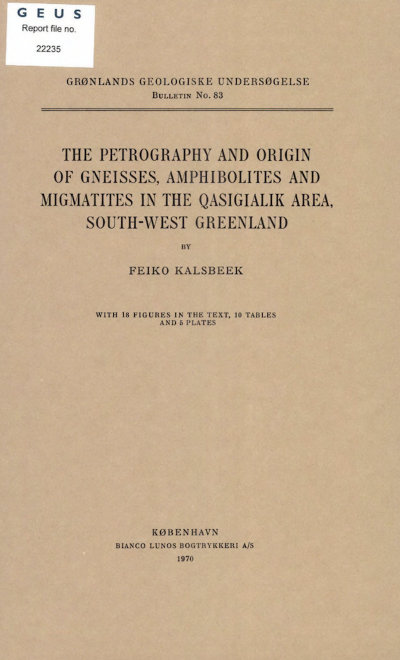The petrography and origin of gneisses, amphibolites and migmatites in the Qasigialik area, South-West Greenland
DOI:
https://doi.org/10.34194/bullggu.v83.6623Abstract
The migmatites from a small area (approx. 200 km2) in SW Greenland are described with special attention to the modal composition of the different rock types. After a general introduction a description of the field relationships of the rocks is given. The leucosome of the migmatites consists of leucocratic veins which mostly have a quartz-dioritic to granodioritic composition; a typical melanosome has rarely been found. The paleosome consists of banded biotite gneisses, hornblende-biotite gneisses and amphibolites. In subordinate quantities occur anorthositic gneisses and garnet-rich gneisses and amphibolites. Spread throughout the area, homogeneous biotite gneisses occur, which locally form large masses, but generally occur as minor outcrops full of inclusions of banded gneisses and amphibolites. These homogeneous gneisses are generally hardly migmatized. The different rock types are petrographically described. Histograms of measured An contents of plagioclase in the different rocks are given. It is shown from a large number of modal analyses that there is a gradual change in plagioclase and quartz content from the banded biotite gneisses via the hornblende-biotite gneisses to the amphibolites (in part). Some of the amphibolites do not fit into this pattern, these amphibolites are also in other respects difierent from the others, among others through the presence of garnet and/or diopside. The homogeneous biotite gneisses may have a granodioritic composition, but the majority of the samples contain hardly any alkali feldspar and agree in modal composition with the banded biotite gneisses, but for a slightly higher amount of biotite in the latter. The leucocratic veins also have often a quartz-dioritic composition which agrees with most of the gneisses, but with a much lower content of dark minerals. The paper is concluded with a discussion of the origin of the difierent rock types, based on the data collected. Most of the rocks are thought to be formed by isochemical metamorphism of geosynclinal sediments. The banded biotite gneisses probably represent original sediments of greywacke to arkose type. Part of the amphibolites probably represent original basic volcanic and tufiaceous rocks, which may have undergone erosion, transport and sedimentation. The hornblende-biotite gneisses are thought to derive from mixtures of normal sediment with varying amounts of tufiaceous material. Alternative interpretations of the gneisses and amphibolites are discussed. The homogeneous gneisses may have formed from the metasediments by a process of homogenization and mobilization. The origin of the leucocratic veins is discussed. The mineralogical composition of the veins and the An content of the plagioclase seem to exclude an origin by anatexis in situ of the gneisses, but the evidence is not conclusive.
Downloads
Published
Issue
Section
License
This article is distributed under a CC-BY 4.0 licence, permitting free redistribution and reproduction for any purpose, even commercial, provided proper citation of the original work. Author(s) retain copyright over the article contents.


